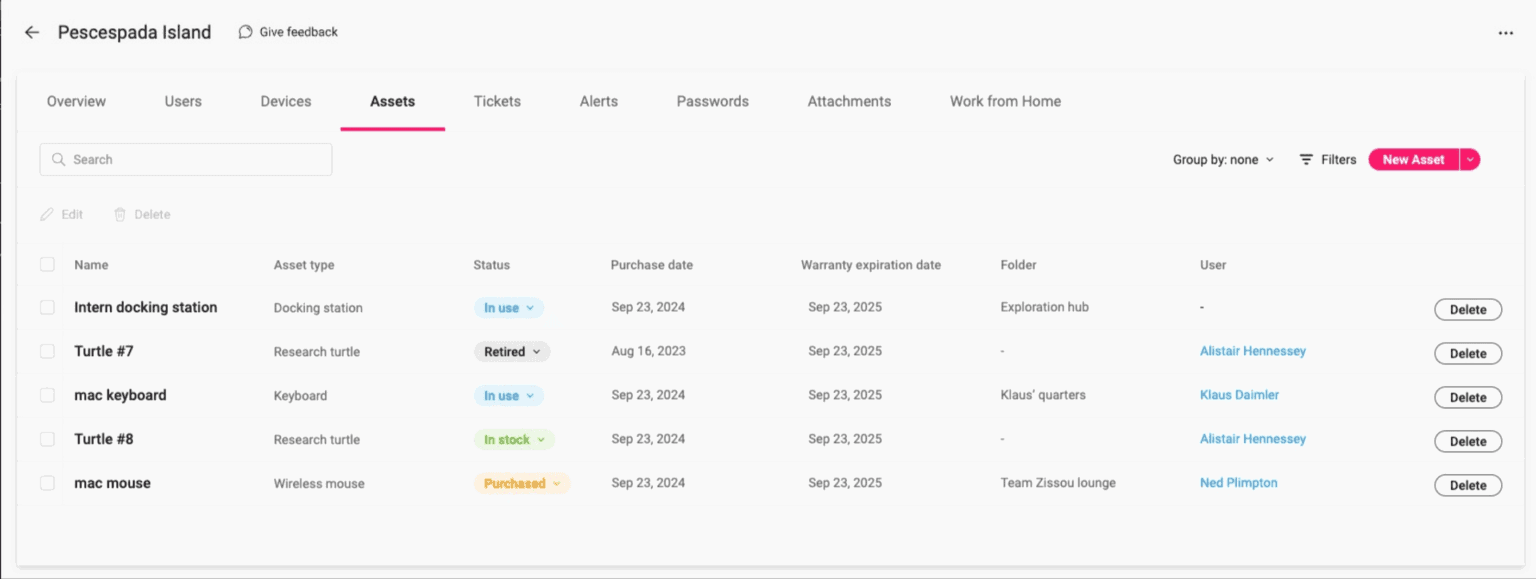Higher Education Inventory Management Made Easy

Higher education inventory management is an essential piece of higher education IT solutions. Discover the ins and outs today.
Colleges and universities around the world are overhauling age-old, manual systems in favor of modern information technology (IT) solutions that effectively equip both educators and students with the resources they need to provide a truly one-of-a-kind learning experience. What’s one revolutionary solution supporting better education? Higher education inventory management.
An effective asset management software for higher education allows collegiate-level institutions to handle inventory needs, auditing, and budget forecasting. In this article, we will delve into the what, why, and how of university management software. Find out how to help your organization streamline operations and explore the many benefits of educational technology.
What is higher education inventory management?
Higher education inventory management is one of the core educational IT solutions. It helps colleges and universities manage all assets, both physical and digital, that are used by educators, students, and staff. These IT solutions track and monitor items like projectors, computers, textbooks, library materials, tablets, instruments, and even software licenses. The collection of resources that can be managed through these technologies is nearly limitless.
While schools at all levels, including K-12, require inventory management, colleges and universities need especially robust higher education asset management software. U.S. News & World Report determined that colleges in the United States have as many as 65,000 undergraduate students – and that doesn’t even cover enrollment in graduate programs like law schools, medical schools, and business schools, which many top universities offer.
With tens of thousands of students, countless departments, numerous educators, and many other additional special programs and interest groups, higher education institutions are tasked with a daunting amount of inventory management needs. A strong university inventory management system allows colleges and universities to understand efficiency, cost-benefit ratio, asset location, and maintenance through one comprehensive dashboard.
An inventory management system for university settings equips users to effectively manage resources throughout their entire lifecycle. These tools help reduce loss and theft, improve asset utilization, ensure timely maintenance, and allow for better budget planning and forecasting. With asset management for higher education, you can expect to see increased operational efficiency, reduced costs, and a learning environment ripe for innovation.
The higher education asset management lifecycle
With higher education inventory management, colleges and universities can make better use of assets throughout their entire lifecycle. The lifecycle of any given asset begins with its initial purchase, and ends with its retirement and replacement. As an example, let’s imagine that a college has invested in X number of licenses for graphic design software in its Makerspace area. We’ll follow this asset through its lifecycle…
Step 1: Purchase and catalog
Based on some student and instructor requests, the university has decided to invest in Adobe Illustrator for student and faculty use in its Makerspace. After comparing prices and choosing the program that has the desired functionality, they purchased these licenses and added them into their higher education inventory management system. The inventory management tool logs the number of licenses, their expiration dates, and more.
Step 2: Assign the resource
Once the asset has been logged in the university management software, it can be assigned to a user, device, or department. In this case, with a digital asset like the Adobe Illustrator program, licenses are assigned to devices. We now also know who is responsible for these assets: The faculty member in charge of the Makerspace, which is part of the Art Department.
Step 3: Request and track maintenance
Let’s imagine that a student encounters an error message when trying to use Adobe Illustrator on one of the tablets in the Makerspace. They report this error to the faculty member in charge of the space, who can then use the higher education inventory management software program to submit a maintenance request through a helpdesk portal. They can also track the status of the ticket as they wait for the university’s IT pros to respond and ensure the resource is up and running again quickly.
Step 4: Audit and forecast
Asset management software for higher education makes it easier to make informed decisions about the future. Administrators and decision-makers will have access to detailed information about asset usage, efficacy, and resilience. These insights allow them to make calls regarding financial resource allocation, physical resource allocation, and future purchases to ensure they are getting the most out of the dollars they spend.
In this example, the school may have purchased Adobe Illustrator licenses for five desktop computers and three tablets. With data from the higher education inventory management tool, they discover that while the tablet programs get a lot of use, the desktop licenses are not utilized to the fullest. It may make more sense to reduce the licenses to three for desktop and add an additional license to another tablet.
Step 5: Retire and replace
When an asset approaches the end of its lifespan, it can be retired from the asset tracking software tool. Based on the auditing and forecasting in the previous stage, another asset may be purchased to replace it, at which point the cycle begins again. For digital assets, decision-making teams can choose whether or not to renew a license, reduce or increase volume, or reallocate funds to a different product.
Why is higher education inventory management important?
Higher education inventory management can help reduce the risk of human error associated with manual inventory processes. Additionally, these tools help streamline purchasing decisions and asset allocation choices, especially when dealing with massive inventories like those typical of college and university settings.
University management softwares increase accountability and visibility into the organization’s assets throughout their life cycles. Plus, they help keep budgets tight by maximizing existing resources and helping to plan and forecast for the future. This in turn cuts down on extra expenditures and ensures that the administration is allocating money where students and professors will get the most benefit.
While higher education asset management software is digital, these tools can track so much more than just digital assets. In addition to technology, software, and electronics, these programs can help keep tabs on physical assets like desks, chairs, maintenance and cleaning equipment, art supplies, and library books. Some programs offer barcoding capabilities, which can be printed and applied to physical assets and then scanned using a mobile app.
Key benefits of higher education inventory management
Now that you have a clear picture of higher education inventory management works and it is an essential component of 21st-century education, let’s go over the key benefits of these modern IT solutions for higher education institutions.
- Increased efficiency: Dated inventory tracking methods like Excel spreadsheets make human error virtually unavoidable. With a modern, digital, and automated system, you can reduce the risk of human error and ensure you have detailed visibility into and data about your assets throughout their lifetimes.
- Improved data and reporting: Today’s higher education inventory management programs provide detailed reporting and analytics on topics like utilization, downtime, and cost-to-benefit ratio. This data allows administrative teams to more effectively allocate resources and plan ahead for asset replacement when necessary.
- Reduced costs: Having a bird’s-eye view of all of your assets means that you can better plan your budget and anticipate upcoming costs. Additionally, increased accountability and visibility reduces the risk of loss and theft – but the biggest cost-reducing factor is the ability to effectively plan for the future.
- Enhanced visibility: With higher education inventory management, wave goodbye to the days of wondering what happened to a certain asset or when it is time to replace something. You’ll be able to access all of this data through a centralized portal. Make sure to look for a program with an intuitive user interface and an accessible learning curve, which will enable the best adoption of the program.
- Improved maintenance tactics: We recommend looking for a higher education inventory management tool that will allow you to handle ticketing and maintenance requests through the same digital interface. This will lead to improved visibility and understanding of your assets as well as quicker ticket resolution rates.
- Compliance: In the world of higher education, there are numerous rules and regulations that must be complied with, especially when grants, scholarships, or federal funding are involved. Higher education inventory management can help you ensure you’re meeting these requirements.
What to look for in your higher education inventory management software tools
With all of these benefits, investing in a higher education inventory management tool is a no-brainer.But how should you decide which one to pick? Here are a few elements to consider.
- Number of assets: How many assets require tracking? Will there be price increases at certain thresholds? For a university or college setting with numerous assets, you may want to choose a program that allows you to track unlimited assets at an all-in-one price.
- Pricing: What is the pricing structure for the software you’re considering? Will you pay a one-time fee or invest in an ongoing subscription model? Will you experience price hikes due to changes in the number of assets, users, or students?
- Mobile use: Can users access the higher education inventory management software through a mobile device or mobile app? Depending on your specific use cases, this can be an important differentiator and can streamline operations.
- Data and reporting: What kind of analytics and data does your educational institution require? Does the program you are looking at meet those needs? How will you be utilizing this data and will it be presented in a digestible format? Effectively selecting the right university management software starts with conducting a comprehensive audit of your needs, budget, and resources.
Atera stands out as a higher education inventory management system

Atera is changing the face of IT for higher education. With network discovery and complete visibility into all of your digital and physical assets, for a complete picture of your entire higher education IT environment at any given moment. With Atera, you can manually add assets or import them in bulk from a spreadsheet, and create asset types to easily organize and manage assets all in one easy to use interface.You can track the inventory lifecycle status from an easy to use color-coded dropdown, and keep track of warranty expiration dates.
If you’d like to learn more about Asset management, check out most recent Community town hall and Asset Management unveiled webinar. You’ll be glad you did!
Ready to give us a try? Reach out to our sales team to start your 30-day free trial today.



